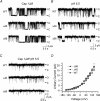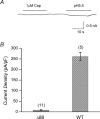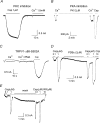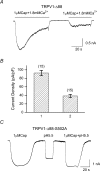Inhibitory modulation of distal C-terminal on protein kinase C-dependent phospho-regulation of rat TRPV1 receptors
- PMID: 15375192
- PMCID: PMC1665281
- DOI: 10.1113/jphysiol.2004.069054
Inhibitory modulation of distal C-terminal on protein kinase C-dependent phospho-regulation of rat TRPV1 receptors
Abstract
The vanilloid receptor TRPV1, previously known as VR1, has been implicated in pain sensation under both physiological and pathological conditions. The channel is highly expressed in sensory ganglion neurones and is activated by a range of noxious stimuli including irritant chemicals, acids and heat. In order to understand the structural basis underlying this polymodal activation and the regulation by intracellular signalling pathways, we have investigated the functional roles of the cytoplasmic C-terminal of rat TRPV1. A mutant with the maximal truncation of the distal C-terminal encompassing the last 88 residues was constructed. Of interest, this mutant exhibited a Ca(2+)-dependent functional loss; it was irresponsive to capsaicin in the presence of extracellular Ca(2+), but fully functional otherwise. Further studies of this construct revealed that extracellular Ca(2+) alone could activate the channel, and that the activation required protein kinase C (PKC) phosphorylation at S502, an event that was up-regulated by external Ca(2+) entry. We compared the truncation mutant with wild-type TRPV1 and demonstrated that it had a significantly increased sensitivity to PKC phosphorylation. These results suggest the distal C-terminal of TRPV1 can inhibit phosphorylation-induced potentiation of the wild-type channel. They also call into question some established functions of the distal C-terminal of TRPV1, including its roles in agonist binding and functional desensitization. We suggest that the functional loss of the truncation mutant, in the presence of extracellular Ca(2+), was not due to disruption of agonist binding or gating, but rather to desensitization promoted by unstimulated extracellular Ca(2+) entry.
Figures








Similar articles
-
Functional changes in the vanilloid receptor subtype 1 channel during and after acute desensitization.Neuroscience. 2007 Oct 12;149(1):144-54. doi: 10.1016/j.neuroscience.2007.07.039. Epub 2007 Aug 8. Neuroscience. 2007. PMID: 17869438
-
Regulation of Ca2+-dependent desensitization in the vanilloid receptor TRPV1 by calcineurin and cAMP-dependent protein kinase.J Biol Chem. 2005 Apr 8;280(14):13424-32. doi: 10.1074/jbc.M410917200. Epub 2005 Feb 3. J Biol Chem. 2005. PMID: 15691846
-
Modality-specific mechanisms of protein kinase C-induced hypersensitivity of TRPV1: S800 is a polymodal sensitization site.Pain. 2015 May;156(5):931-941. doi: 10.1097/j.pain.0000000000000134. Pain. 2015. PMID: 25734989 Free PMC article.
-
TRPV1 receptors in sensitisation of cough and pain reflexes.Pulm Pharmacol Ther. 2009 Apr;22(2):65-70. doi: 10.1016/j.pupt.2008.12.014. Epub 2008 Dec 27. Pulm Pharmacol Ther. 2009. PMID: 19141328 Review.
-
Structure and function of TRPV1.Pflugers Arch. 2005 Oct;451(1):143-50. doi: 10.1007/s00424-005-1457-8. Epub 2005 Jun 22. Pflugers Arch. 2005. PMID: 15971082 Review.
Cited by
-
Uncoupling proton activation of vanilloid receptor TRPV1.J Neurosci. 2007 Nov 21;27(47):12797-807. doi: 10.1523/JNEUROSCI.2324-07.2007. J Neurosci. 2007. PMID: 18032651 Free PMC article.
-
Activity and Ca²⁺ regulate the mobility of TRPV1 channels in the plasma membrane of sensory neurons.Elife. 2015 Jan 8;4:e03819. doi: 10.7554/eLife.03819. Elife. 2015. PMID: 25569155 Free PMC article.
-
Proton inhibition of unitary currents of vanilloid receptors.J Gen Physiol. 2009 Sep;134(3):243-58. doi: 10.1085/jgp.200910255. J Gen Physiol. 2009. PMID: 19720962 Free PMC article.
-
A hot-sensing cold receptor: C-terminal domain determines thermosensation in transient receptor potential channels.J Neurosci. 2006 May 3;26(18):4835-40. doi: 10.1523/JNEUROSCI.5080-05.2006. J Neurosci. 2006. PMID: 16672657 Free PMC article.
-
Voltage is a partial activator of rat thermosensitive TRP channels.J Physiol. 2007 Dec 1;585(Pt 2):469-82. doi: 10.1113/jphysiol.2007.144287. Epub 2007 Oct 11. J Physiol. 2007. PMID: 17932142 Free PMC article.
References
-
- Bhave G, Zhu W, Wang H, Brasier DJ, Oxford GS, Gereau RW. cAMP-dependent protein kinase regulates desensitization of the capsaicin receptor (VR1) by direct phosphorylation. Neuron. 2002;35:721–731. - PubMed
-
- Caterina MJ, Leffler A, Malmberg AB, Martin WJ, Trafton J, Petersen-Zeitz KR, Koltzenburg M, Basbaum AI, Julius D. Impaired nociception and pain sensation in mice lacking the capsaicin receptor. Science. 2000;288:306–313. - PubMed
-
- Caterina MJ, Schumacher MA, Tominaga M, Rosen TA, Levine JD, Julius D. The capsaicin receptor: a heat-activated ion channel in the pain pathway. Nature. 1997;389:816–824. 10.1038/39807. - DOI - PubMed
Publication types
MeSH terms
Substances
Grants and funding
LinkOut - more resources
Full Text Sources
Other Literature Sources
Miscellaneous

